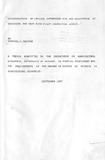| dc.description.abstract | Large scale irrigation systems, especially those requiring
pumped water, are costly investments and generally require
subsidization. Of all the seven large schemes in Kenya,
covering 9,000 hectare, only the gravity-fed Mwea Tabere
rice scheme has had positive cash flows. The big losses
made by these schemes have cost the Hinistry of Agriculture
on average, 25 per cent of its total annual budget for the
last four years.
To reverse this situation and make irrigation schemes
productive, it is important that well tested technology and
comprehensive plans are prepared. This study was an effort
toward such plans. The main objective of the study was to
determine an optimal'enterprise mix for West Kano Pilot
Irrigation Scheme, which is one of Kenya's large scale
irrigation schemes. Determination of such an enterprise mix
would help in allocating the available resources optimally
and thus maximizing the tenant's income. This is in line
with the objectives of the task force set up by the Ministry
of Agriculture to look into alternative cost-effective ways
of developing Kenya's irrigation potential.
Both primary and secondary data were used in this study.
Data on inputs, yields, input-output coefficientB and
prices was collected between December 1986 and January
1987. Linear programming wa s chosen as the main tool for
data analysis.
A slight modification was done on the ordinary linear
programming model in order to fully include the perennial
sugar cane crop in the analysis.
Results from this study showed that it is possible to more
than double the incomes received by tentants in this scheme
from the present KShs.9,033.30 to KShs.18,484.67 per annum.
If the optimal enterprise mix is adopted the scheme can
also save more than KShs.3 million per year in operating
capital. This was a clear indication that the scheme can
contribute positively to the development of the area. The
negative cash flows made in the past can actually be halted.
The optimal enterprise mix obtained in this study requires
that the tenant allocate 1.92 acres of his plot to rice in
the short rains, 2.8 acres to green grams in the long rains
season and 1.2 acres to sugar cane. With such a farm plan,
marketing capacity for sugar cane and short rains land we"re
found to be the most limiting resources to crop production
in the scheme. Green grams was found to be a very
profitable enterprise in the scheme, earning the tenant a
gross margin of KShs.5,454 per annum as compared to
KShs.5,321 from rice. It is thus recommended that green
grams should be added to rice and sugar cane as a third
scheme crop. | en |

